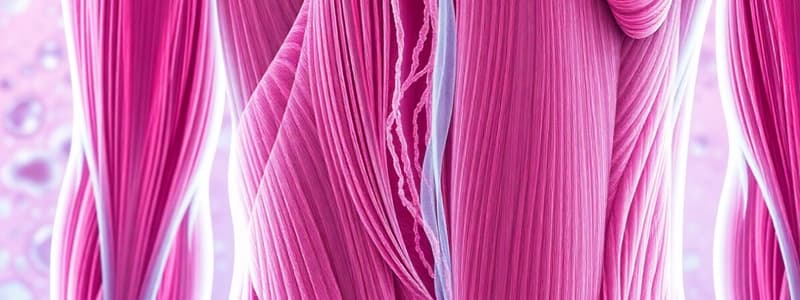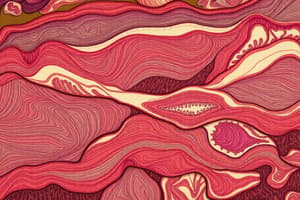Podcast
Questions and Answers
What is the primary function of skeletal muscle?
What is the primary function of skeletal muscle?
- Regulating internal organs
- Consciously controlled movement (correct)
- Sensory perception
- Involuntary movement
What is the role of mitochondria in muscle cells?
What is the role of mitochondria in muscle cells?
- Storage of calcium ions
- Production of ATP (correct)
- Regulating muscle contraction
- Synthesis of myofilaments
Which component directly covers the active sites on G-actin?
Which component directly covers the active sites on G-actin?
- Tropomyosin (correct)
- Myosin
- F-actin
- Troponin
What are the globular proteins that make up the strands of actin called?
What are the globular proteins that make up the strands of actin called?
How do transverse tubules function in muscle cells?
How do transverse tubules function in muscle cells?
Which type of muscle is primarily responsible for respiration?
Which type of muscle is primarily responsible for respiration?
What is the function of capillary beds in skeletal muscle?
What is the function of capillary beds in skeletal muscle?
What stabilizes joints and maintains body positions?
What stabilizes joints and maintains body positions?
Which protein plays a critical role in muscle contraction regulation and interacts with calcium?
Which protein plays a critical role in muscle contraction regulation and interacts with calcium?
During muscle contraction, what happens to the active sites on G-actin?
During muscle contraction, what happens to the active sites on G-actin?
What is the term for the unit of contractile proteins connected in series along the length of muscle?
What is the term for the unit of contractile proteins connected in series along the length of muscle?
Which structure is responsible for storing calcium in skeletal muscle cells?
Which structure is responsible for storing calcium in skeletal muscle cells?
Which component of muscle fibers primarily enables elasticity?
Which component of muscle fibers primarily enables elasticity?
What is the role of the M-line in a sarcomere?
What is the role of the M-line in a sarcomere?
Which term describes the binding of myosin and actin to pull actin towards the M-line?
Which term describes the binding of myosin and actin to pull actin towards the M-line?
What is found in the I-band of a sarcomere?
What is found in the I-band of a sarcomere?
What is the primary role of dystrophin in muscle cells?
What is the primary role of dystrophin in muscle cells?
Which muscle structure is responsible for dividing muscle fibers into individual units?
Which muscle structure is responsible for dividing muscle fibers into individual units?
Which of the following best describes the role of myoglobin in muscle tissue?
Which of the following best describes the role of myoglobin in muscle tissue?
What is the significance of the triad in muscle cells?
What is the significance of the triad in muscle cells?
Flashcards
Sarcolemma
Sarcolemma
The outer membrane of a muscle cell, responsible for transmitting electrical signals.
Sarcoplasm
Sarcoplasm
The cytoplasm of a muscle cell, containing the cell's working parts.
Mitochondria
Mitochondria
Powerhouses of the muscle cell, responsible for producing energy (ATP).
Myofibrils
Myofibrils
Signup and view all the flashcards
Transverse Tubules
Transverse Tubules
Signup and view all the flashcards
F-actin
F-actin
Signup and view all the flashcards
G-actin
G-actin
Signup and view all the flashcards
Active Site
Active Site
Signup and view all the flashcards
Tropomyosin
Tropomyosin
Signup and view all the flashcards
Troponin
Troponin
Signup and view all the flashcards
Contractility
Contractility
Signup and view all the flashcards
Excitability
Excitability
Signup and view all the flashcards
Extensibility
Extensibility
Signup and view all the flashcards
Elasticity
Elasticity
Signup and view all the flashcards
Actin myofilaments
Actin myofilaments
Signup and view all the flashcards
Myosin myofilaments
Myosin myofilaments
Signup and view all the flashcards
Sarcomere
Sarcomere
Signup and view all the flashcards
Terminal cisternae
Terminal cisternae
Signup and view all the flashcards
Triad
Triad
Signup and view all the flashcards
Titin
Titin
Signup and view all the flashcards
Study Notes
Skeletal Muscle
- Skeletal muscles are consciously controlled and responsible for body movement; they are attached to bones.
- Muscle function includes posture maintenance, respiration and heat production.
- Skeletal muscles are made up of muscle fibers (cells) that are long, cylindrical and multinucleated.
- Myoblasts (immature muscle cells) fuse to form muscle fibers.
- Muscle fibers exhibit striations (light and dark bands due to protein organization).
- Skeletal muscles are composed primarily of muscle fibers (cells) surrounded by connective tissues, blood vessels, and nerves.
Muscle Histology
- Sarcolemma: The outer plasma membrane of a muscle cell.
- Sarcoplasm: The cytoplasm of a muscle cell, containing many mitochondria (powerhouses of the cell) for ATP production
- Myofibrils: Highly organized protein structures within muscle cells; they extend the entire length of the cell.
- Myofilaments: Contractile proteins (actin and myosin) form repeating patterns, creating sarcomeres, which are the basic contractile units.
- T-tubules: Invaginations of the sarcolemma, allowing action potentials to reach the interior of the muscle fiber, facilitating calcium release.
- Sarcoplasmic Reticulum (SR) Smooth ER that stores calcium ions and releases them during muscle contractions.
- Terminal cisternae: Enlarged regions of the SR adjacent to T-tubules, important for calcium storage.
- Triad: A unit formed by a T-tubule and two terminal cisternae.
Myofilaments
- Actin (thin filaments): made up of G-actin (globular proteins) with active sites for myosin binding; also includes tropomyosin and troponin.
- Myosin (thick filaments): made up of myosin filaments with heads that can bind to actin, driving contraction.
- Sarcomere: Structural and functional unit of muscle fibers, extending from Z-disc to Z-disc.
- Z-disc: Proteins that connect and organize actin filaments.
- M-line: Protein structure in the middle of the sarcomere, connecting myosin filaments.
- I-band: Region containing only actin filaments.
- H-zone: Region containing only myosin filaments.
- A-band: Region including both myosin and the overlapping portions of actin filaments.
- Cross-bridges: Myosin heads binding to actin during muscle contraction
- Myoglobin: Protein in muscle cells that binds and stores oxygen.
- Glycogen granules: Store carbohydrates for energy.
Gross Anatomy of Skeletal Muscle Structure
- Tendons: Dense connective tissue attaching muscle to bone.
- Fascicles: Bundles of muscle fibers.
- Endomysium: Connective tissue surrounding individual muscle fibers.
- Perimysium: Connective tissue surrounding fascicles.
- Epimysium: Connective tissue surrounding the entire muscle.
- Muscles are made up of multiple fascicles bundled together.
Muscle Fiber Structure and Properties
- Muscle cells are long, cylindrical, and multinucleated, containing myofibrils.
- Muscles can shorten by contracting and can elongate from other forces.
- They exhibit contractility (able to shorten), excitability (respond to APs), extensibility (extend beyond resting length), and elasticity (return to original length after extension).
Studying That Suits You
Use AI to generate personalized quizzes and flashcards to suit your learning preferences.




